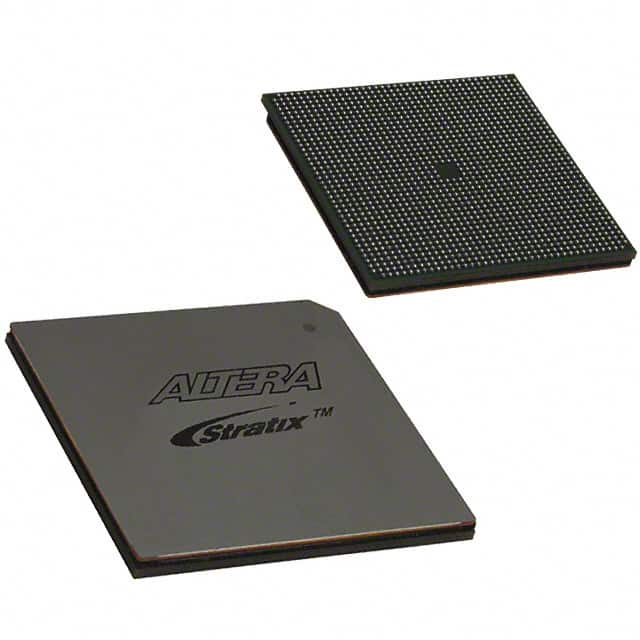EP1S80F1508C7
Product Overview
- Category: Integrated Circuit (IC)
- Use: Digital Signal Processing (DSP)
- Characteristics: High-performance, low-power consumption
- Package: 1508-ball FineLine BGA package
- Essence: Advanced programmable logic device
- Packaging/Quantity: Individually packaged, quantity varies based on supplier
Specifications
- Manufacturer: Intel Corporation
- Technology: 90nm Stratix II
- Logic Elements: 80,000
- Embedded Memory: 1.5 Mbits
- Operating Voltage: 1.2V
- Operating Temperature: -40°C to 100°C
- Clock Speed: Up to 400 MHz
- I/O Pins: 1,152
- Power Consumption: Varies based on configuration and usage
Detailed Pin Configuration
The EP1S80F1508C7 has a complex pin configuration with 1508 pins. The pins are organized into various groups, including power supply pins, ground pins, input/output pins, configuration pins, and clock pins. Each pin serves a specific purpose in the functioning of the integrated circuit.
For a detailed pin configuration diagram, please refer to the manufacturer's datasheet.
Functional Features
- High-performance digital signal processing capabilities
- Flexible and programmable logic elements for customization
- Low-power consumption for energy-efficient operation
- Extensive I/O capabilities for versatile connectivity
- Embedded memory for efficient data storage and retrieval
- Support for advanced communication protocols and interfaces
Advantages and Disadvantages
Advantages: - High processing power for demanding applications - Programmable nature allows for flexibility and adaptability - Low-power consumption reduces energy costs - Ample I/O pins enable seamless integration with other devices - Support for various communication protocols enhances compatibility
Disadvantages: - Complex pin configuration may require careful design considerations - Higher cost compared to simpler integrated circuits - Limited embedded memory capacity for certain applications - Requires expertise in digital signal processing for optimal utilization
Working Principles
The EP1S80F1508C7 is based on the 90nm Stratix II technology, which utilizes programmable logic elements and embedded memory to perform digital signal processing tasks. The device operates at a low voltage of 1.2V and can handle clock speeds of up to 400 MHz.
By configuring the logic elements and utilizing the embedded memory, the IC can process and manipulate digital signals with high precision and efficiency. The flexible nature of the device allows it to be customized for specific applications, making it suitable for a wide range of digital signal processing tasks.
Detailed Application Field Plans
The EP1S80F1508C7 finds applications in various fields that require advanced digital signal processing capabilities. Some potential application areas include:
- Telecommunications: Signal processing in wireless communication systems, base stations, and network infrastructure.
- Audio/Video Processing: Real-time video encoding/decoding, audio processing, and multimedia applications.
- Industrial Automation: Control systems, robotics, and machine vision applications.
- Medical Imaging: Image processing in medical diagnostics, MRI, CT scans, and ultrasound imaging.
- Aerospace and Defense: Radar systems, satellite communication, avionics, and military applications.
These are just a few examples, and the versatility of the EP1S80F1508C7 allows it to be used in many other fields where high-performance digital signal processing is required.
Detailed and Complete Alternative Models
- EP1S40F780C6: A lower-capacity variant with 40,000 logic elements and 780 I/O pins.
- EP1S160F1508C7: A higher-capacity variant with 160,000 logic elements and 1,508 I/O pins.
- EP1S30F1020C6: A lower-cost variant with 30,000 logic elements and 1,020 I/O pins.
- EP1S120F1152C7: A mid-range variant with 120,000 logic elements and 1,152 I/O pins.
These alternative models offer different combinations of logic elements, I/O pins, and cost to cater to various application requirements.
기술 솔루션에 EP1S80F1508C7 적용과 관련된 10가지 일반적인 질문과 답변을 나열하세요.
Sure! Here are 10 common questions and answers related to the application of EP1S80F1508C7 in technical solutions:
Q1: What is EP1S80F1508C7? A1: EP1S80F1508C7 is a specific model of Field-Programmable Gate Array (FPGA) manufactured by Intel.
Q2: What are the key features of EP1S80F1508C7? A2: EP1S80F1508C7 offers high-performance logic, embedded memory blocks, digital signal processing (DSP) capabilities, and various I/O interfaces.
Q3: What are the typical applications of EP1S80F1508C7? A3: EP1S80F1508C7 is commonly used in applications such as telecommunications, industrial automation, automotive systems, aerospace, and defense.
Q4: How can EP1S80F1508C7 be programmed? A4: EP1S80F1508C7 can be programmed using Hardware Description Languages (HDLs) like VHDL or Verilog, or through graphical programming tools like Quartus Prime.
Q5: What is the maximum operating frequency of EP1S80F1508C7? A5: The maximum operating frequency of EP1S80F1508C7 depends on the design and implementation, but it can typically reach several hundred megahertz.
Q6: Can EP1S80F1508C7 interface with other devices? A6: Yes, EP1S80F1508C7 supports various I/O standards, including LVDS, SSTL, HSTL, and LVTTL, allowing it to interface with a wide range of external devices.
Q7: Does EP1S80F1508C7 have built-in memory? A7: Yes, EP1S80F1508C7 includes embedded memory blocks (RAM) that can be used for data storage or as lookup tables.
Q8: Can EP1S80F1508C7 handle digital signal processing tasks? A8: Yes, EP1S80F1508C7 has dedicated DSP blocks that enable efficient implementation of algorithms commonly used in digital signal processing applications.
Q9: What is the power consumption of EP1S80F1508C7? A9: The power consumption of EP1S80F1508C7 depends on the design and operating conditions but typically ranges from a few watts to tens of watts.
Q10: Are there any development boards available for EP1S80F1508C7? A10: Yes, Intel provides development boards and evaluation kits specifically designed for EP1S80F1508C7, which can aid in prototyping and testing of designs.
Please note that these answers are general and may vary depending on specific requirements and implementations.


